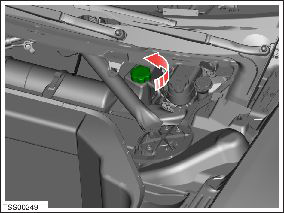Tesla Model S: Cooling System - Partial Refill and Bleed
Tesla Model S (2012-2025) Service Manual / Thermal Management / Cooling System - Partial Refill and Bleed
Refill
Caution: Use the specified coolant only. In this manual, refer to General Information > Capacities, Fluids, and Lubricants > Fluids.
- Remove the coolant reservoir cap (refer to procedure).

- Connect a laptop with Toolbox to the vehicle.
- In Toolbox, select Views > Thermal > Fluid Drain and Fill.
- Ensure that the "Coolant fill" box is checked. Caution: Ensure that the vehicle is not charging before continuing to the next step in this procedure.
- Click the Start/Play button.
- Fill the reservoir to the "MAX" line with the specified coolant while the "Fluid Drain and Fill" routine is running.
- In Toolbox, select Views > Thermal > Coolant Air Purge. Run the coolant air purge routine.
- Carefully monitor the coolant level while the routine is running, adding coolant as required. Note: Do not allow the fluid level to drop below the "MIN" line during this procedure. Otherwise, air enters the system and the procedure must be repeated.
- The coolant level should stabilize before the routine ends. If the coolant level is still dropping, perform the routine again.
- Ensure that the coolant level is between the "NOM" and "MAX" lines.
- Install the coolant reservoir cap.
READ NEXT:
 Cooling System - Drain and Refill
Cooling System - Drain and Refill
Note: Make sure at least 14 L of the specified coolant is
available before beginning this procedure.
Caution: Use the specified coolant only. In this manual, refer
to General Informati
 Coolant System - Check and Fill
Coolant System - Check and Fill
Check & Top-Up
Remove coolant cap from reservoir.
Fill reservoir to correct level.
Reinstall the cap.
 Cooling System - Vacuum Refill
Cooling System - Vacuum Refill
Note: Make sure at least 14 L of the specified coolant is
available before beginning this procedure.
Caution: Use the specified coolant only. In this manual, refer
to General Informati
SEE MORE:
 Brake Caliper - Rear - LH (Remove and Replace)
Brake Caliper - Rear - LH (Remove and Replace)
Warning: If the vehicle
has air suspension, activate "Jack" mode on the touchscreen before
raising and supporting the vehicle.
Removal
Remove the rear underhood apron
(refer to procedure).
Remove the brake fluid reservoir cap and place
an absorbent materi
 Trim - Touch Screen Surround (Remove and Replace)
Trim - Touch Screen Surround (Remove and Replace)
Removal
Remove the MCU/touch screen (refer to procedure).
Remove the screws (x6) that secure the touch screen surround
(torque 4 Nm).
Cut the cable tie that secures the Bluetooth antenna to the edge
clip on the bezel.
Remove the bezel from the MCU.
Remove the screws
© 2019-2025 Copyright www.tesms.org

